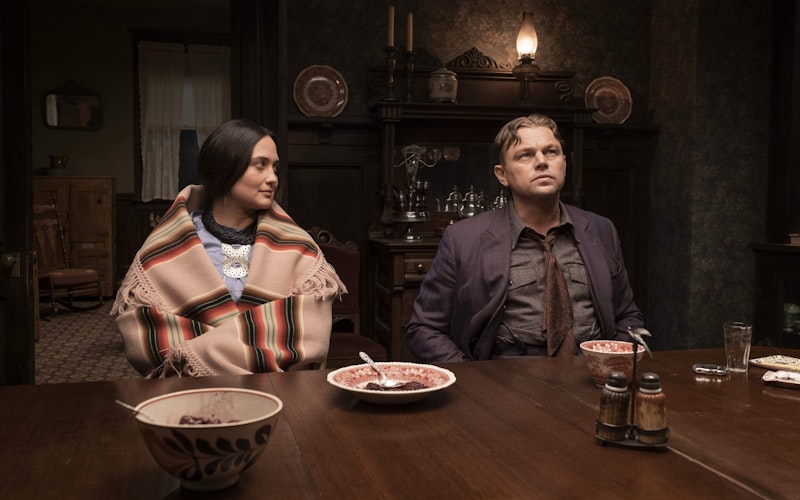
Movies
False Apostles and Deceitful Workers in Killers of the Flower Moon
In his second letter to the Corinthians, Paul warns a vulnerable people to beware of “false apostles” and “deceitful workers,” stating that “Satan himself masquerades as an angel of the light.” Such masquerading abounds in Martin Scorsese’s Killers of the Flower Moon.
The first 30 minutes of the film follow a familiar pattern for Hollywood epics. A disillusioned war veteran, ironically named “Ernest” (Leonardo DiCaprio), arrives in Osage County, Oklahoma, in the 1920s. He soon woos and falls in love with the effervescent Mollie (Lily Gladstone), an indigenous Osage woman newly wealthy from her headrights to the oil that has been found on Osage land. Simultaneously, Ernest’s benevolent and civic-minded uncle, William Hale (Robert De Niro), mentors and advocates for the well-being of his adopted Osage community. “They are the finest people in the world,” Hale marvels to anyone who will listen. When the Osage start mysteriously dying, surely these resourceful, philanthropic white men will sacrifice themselves if necessary to save their friends from their collective misery. That’s the white-savior trope, right?
But Killers of the Flower Moon is not Dances with Wolves or The Last Samurai or Lawrence of Arabia. (Spoilers ahead.) Scorsese’s stealthy adaptation of David Grann’s wrenching nonfiction book about white Americans systematically marrying, then murdering, members of the Osage nation introduces, then subverts the notion of the white savior. As has been widely reported, early drafts of the script placed the aptly named federal agent Tom White at the center of the story, crusading in from Washington to save the day. Indeed, DiCaprio originally signed on to play White. After working extensively with Osage consultants, however, the director shifted the focus, including recasting his leading man to play the deeply flawed Ernest and reducing White (Jesse Plemmons) to a secondary character. In his new role, DiCaprio’s white-savior character is a wolf in sheep’s clothing, albeit a dim-witted and conflicted one. While still keeping white actors at the center of the film, Scorsese’s surreptitious reframing poisons the white-savior narrative with a lethal and terrifying dose of truth.
The shocking power of Killers of the Flower Moon derives from how convincingly the major movie stars who headline the movie masquerade as saviors. When De Niro’s Hale notices Mollie’s sister, Minnie (Jillian Dion), noticeably ill at a wedding party, he authentically lays his hands upon her and lifts her up in prayer in her own language. Only a hardened cynic could assume this doting grandfather capable of engineering her poisoning. More disturbing is the way DiCaprio’s Ernest treats his beloved Mollie. Filmed with gentle care in amber shades, their courtship rings true and pure. When Mollie coyly talks in her own language, a charmed and charming Ernest replies, “I don't know what you said, but it must've been Indian for handsome devil.” Watching them together is wholly incompatible with the unexplained revelation that Ernest routinely robs wealthy Osage headright holders at gunpoint; later, he graduates to murder. Most disturbing is Ernest’s shocking lack of fidelity to Mollie. Yes, their love is real, but he is weak. “I just love money,” he proclaims. “I love it as much as I love my wife.”
Masquerading abounds in Killers of the Flower Moon.
Mollie’s naivety concerning her husband’s evil actions complicates the story. I have a female friend who walked out of the movie because she was so furious that Mollie did not see through her husband’s duplicity. While I certainly understand this criticism, Gladstone’s subtle yet radiant performance leads me to a different conclusion. Mollie’s vulnerability to Ernest’s lies testifies to her purity and faithfulness. In the book of Matthew, Jesus warns his apostles, “I am sending you out like sheep among wolves. Therefore, be as shrewd as snakes and as innocent as doves.” To her misfortune, but also maybe to her credit, Mollie’s pure and holy spirit resides exclusively with the doves.
If a latent warning for Christians abides somewhere in the diabolical storyline of Killers of the Flower Moon, perhaps it comes from an awareness of our human capacity to deceive ourselves. Blinded by his sense of white privilege and entitlement, Hale convinces himself and his weak-minded nephew of the inevitability of the demise of the Osage people. Tempted by wealth and status, the masqueraders contrive that their vice and virtues live as compatible forces of providence. When Ernest’s love for Mollie threatens to interfere, Hale exhorts his nephew: “Expectin' a miracle to make all this go away? You know they don't happen anymore.” In their twisted view, external fate, not their murderous intent, brings about Mollie’s eventual destruction. Hale and Ernest seem to believe their self-serving lies.
Like many, I confess to being a longtime fan of several white-savior films. A movie like Dances with Wolves thrilled me with its redemptive story and certainly made my younger self more informed and empathetic to the plight of Native Americans. However, the white heroes of such films also probably made me feel slightly better about myself. Less complicit. As we strive for the biblical mandate of true reconciliation, Killers of the Flower Moon may offer a more significant story on the painful journey toward accountability. Unlike its white-savior counterparts, Scorsese’s lacerating western epic painfully reminds us that, for the most part, white people predominantly played the antagonists, not the saviors, in the colonization of the continent, often masquerading—to return to Pauls’ words—as servants of righteousness.
Topics: Movies